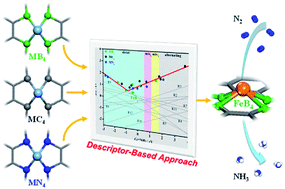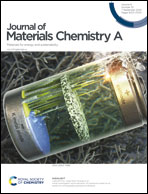The rational design of single-atom catalysts for electrochemical ammonia synthesis via a descriptor-based approach†
Abstract
Single-atom catalysts (SACs) have been widely studied in electrocatalysis towards renewable energy conversion. Herein, we present a general descriptor-based strategy for the rational design of SACs via density functional theory calculations. Taking the electrochemical nitrogen reduction reaction (NRR) as an example, we firstly revealed the scaling relations for adsorption energies of intermediates on a series of 4-B (MB4), 4-C (MC4) and 4-N (MN4) coordinated SACs. Based on this, the activity of the NRR was described by the adsorption free energy of *NH. It's found that MB4, MC4 and MN4 followed the same volcano curve of activity, where FeB4 was optimal with a limiting potential of −0.55 V. On MB4, the H adsorption energies were weaker than on widely studied MC4 and MN4 due to the highly occupied H 1s–d antibonding state, which resulted in a higher NRR selectivity of MB4. More strikingly, kinetic calculations suggested that the activation energy of the NRR (0.99 eV) is lower than that of the HER (1.10 eV) on FeB4 at 0 V vs. RHE, and hence the ammonia production should be more feasible than hydrogen evolution on FeB4. This work not only reported MB4 as a potential NRR electrocatalyst, where FeB4 was the most outstanding, but also generalized the descriptor-based approach to the rational design of widely studied SACs.



 Please wait while we load your content...
Please wait while we load your content...